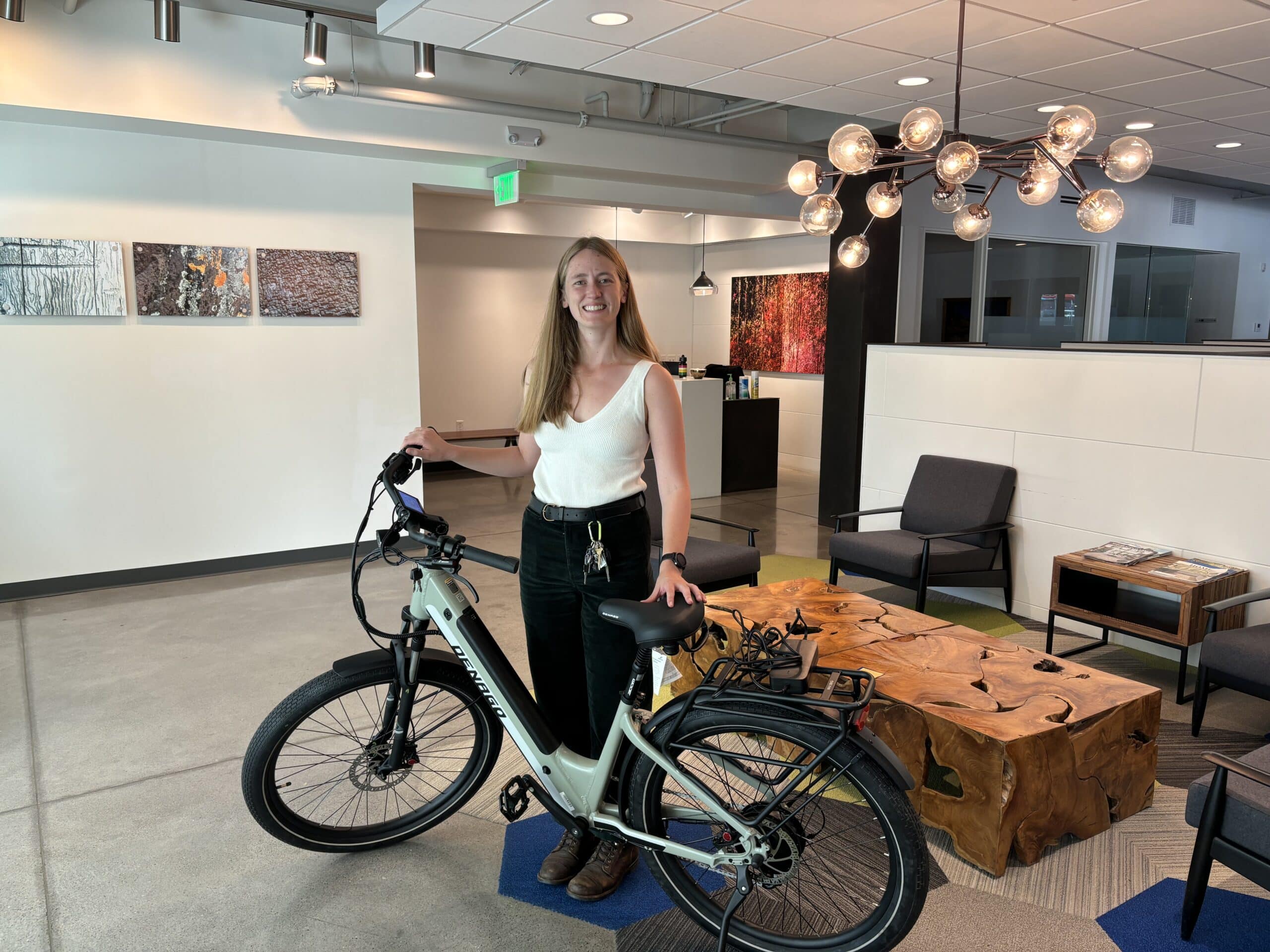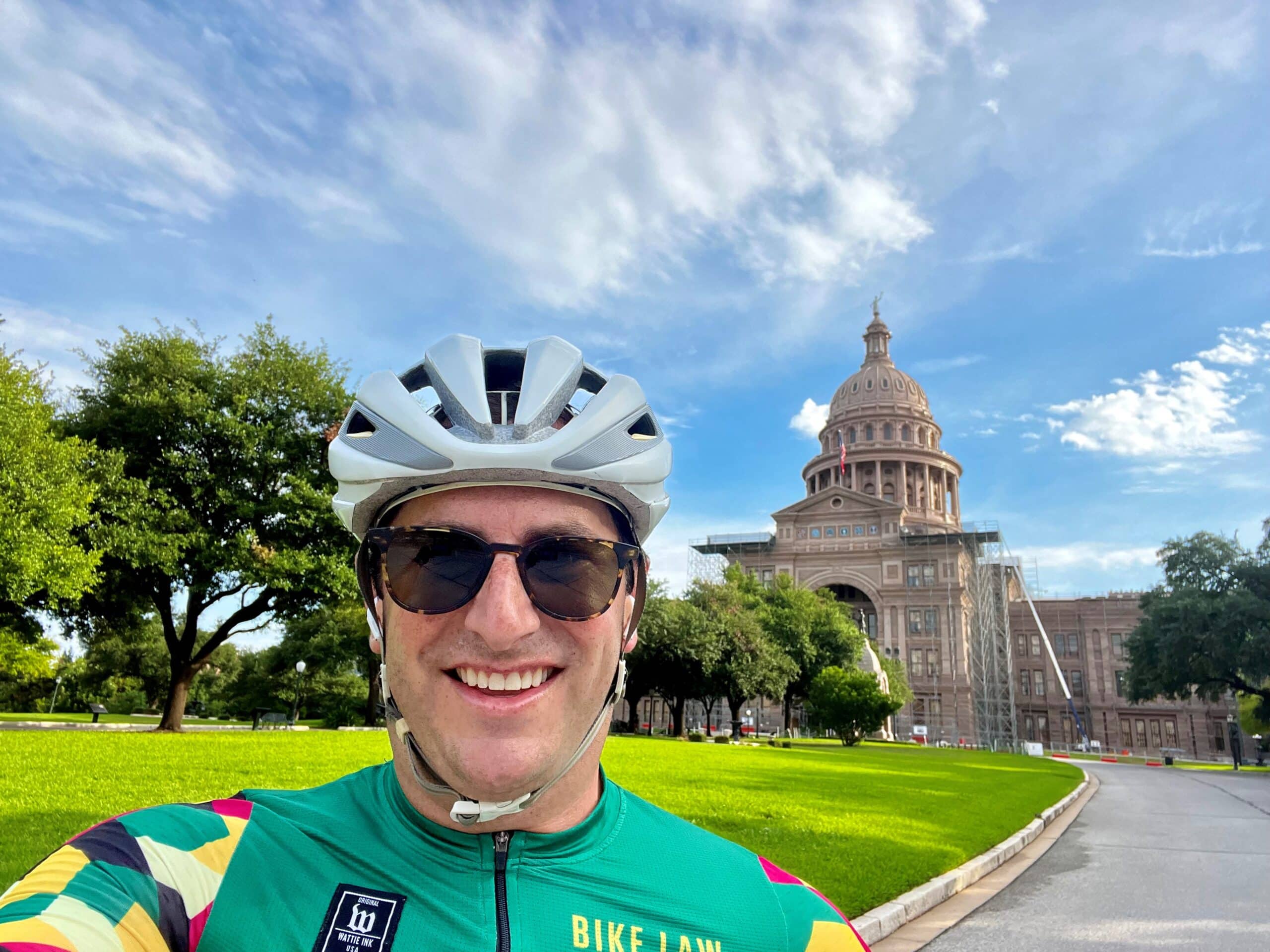Coach Oke’s Ghost Bike
Several years ago, I was jogging alongside Reid Park in Tucson, Arizona when suddenly I was greeted by an old ghost bike. The stark white frame of the bicycle memorial juxtaposed against the soft, dusty hues of the desert landscape immediately caught my attention. What retained it was a hand-painted sign written in youthful lettering amidst a bloom of silk flowers on the ghost bike that read, “Coach Oke.”

As a bike crash attorney, I am hyperaware of ghost bikes. Ghost bikes, like the one left for Coach Oke in Tucson, are public memorials parked on public ways near deadly crash sites. They generally serve two purposes. First, they honor the lives of bicyclists who have died in traffic crashes. Second, they remind drivers of their duty to operate with due care around bicyclists.
At the time of my encounter with Coach Oke’s ghost bike, the concept of ghost bike memorials was not new to me, yet there was something compelling about his memorial. Maybe it was the unsettling location of his haunt (a public park near playgrounds and soccer fields), or possibly I felt the hands and hearts of the people Coach Oke had touched coming from the memorial they had left for him. Whatever it was, it was unshakeable.
Upon returning home, I found a 2009 news story online where I discovered Coach Oke’s full name: Drake G. Okusako. I learned that Drake coached youth soccer, served in the army, enjoyed photography, regularly went to the library, loved riding his bicycle, and died tragically “when a car struck him in the bike lane of Alvernon Way near East Broadway.”
Reflection
Since this encounter several years ago, I have had occasion to revisit and reflect on Coach Oke’s untimely death, along with so many other preventable traffic deaths. Similar tragedies involving cyclists and pedestrians continue to occur regularly in Maine where I live and work, as well as across the United States. During moments of pause and reflection on these tragedies, I often find myself asking a question that so many of us in the bicycling advocacy community repeatedly revisit: How do we get drivers to start seeing—and stop killing—people riding bikes?
Sure, ghost bike memorials can be effective ways to get drivers to pay attention to cyclists. And, yes, building better infrastructure, investing in public education, and advocating for stronger law enforcement are absolute givens. However, I am increasingly convinced that in order to truly bring about change, we need to couple ghost bike memorials, public policy solutions and other long-term solutions with an immediate commitment to driving with real 20-20 vision.
What Does It Mean to Drive with Real 20-20 Vision?
Driving with real 20-20 vision means more than passing a 20-20 eye examination at the Bureau of Motor Vehicles or purchasing corrective lenses from an optometrist. It requires recognizing and addressing our cognitive limitations as drivers, slowing down, and reshaping our perceptions of public space and who belongs in it. Let me elaborate on the concept and how we can put it in place.
- Recognizing The Dangers of Selective Attention
Driving with 20-20 vision begins with an acknowledgment that our selective attention is preventing us from seeing much of what is around us. The concept of selective attention is perhaps best illustrated by the famous Invisible gorilla and other videos compiled by Christopher Chabris and Daniel Simons, who teach that the vast majority of our population lacks comprehensive visual awareness, particularly when hyperfocused on a task. On the roadway, most drivers are so hyperfocused on the task of seeing and responding to other motor vehicle traffic that they become virtually blind to bicycle and pedestrian traffic. This is so even when bicyclists and pedestrians are in well-lit locations, wearing high visibility clothing, and have the lawful right-of-way. So, the first step to addressing vulnerable road user deaths is recognizing that we, as drivers, start off each of our road trips handicapped by our selective attention and, therefore, have to make a conscious effort to look for all forms of traffic (including non-motorized traffic) as we proceed with travel.
- Seeing Pink Kittens
A related and well-known way to prevent the deaths of vulnerable road users and others on our roadways involves putting away external distractions, such as cell phones, that are likely to add to the difficulties with selective attention that already challenge our ability to drive with real 20-20 vision. Studies done by the insurance industry and other entities have shown that while almost all drivers acknowledge that distracted driving is a societal problem that we need to address, most people continue to use cell phones, text, and eat while driving because they believe their driving skills are superior to others and/or feel that they have a unique ability to multi-task and pay attention to the roadway. However, as this “pink kitten” distracted driving video from the United Kingdom shows, during those brief moments when we turn our attention to our phones, a drink in the console, or handing a snack to our children in the backseat, we can miss more than one pink kitten (or more than one person), and that vision deficit can have lasting consequences. The truth is no one is immune from the tragedies associated with distracted driving.
- Slowing It Down
Driving with real 20-20 vision also requires driving slow enough to have sufficient time to perceive and react to other traffic, including bicycle and pedestrian traffic. Importantly, driving at a safe speed does not always mean driving at or around the posted speed limit. Often weather, light, the presence of vulnerable road users, and/or surface conditions require operation of our motor vehicles below the speed limit. All too frequently drivers who kill or injure bicyclists are driving much too fast for the circumstances. It is also no surprise that studies by the National Highway Safety Traffic Safety Administration, the AAA Foundation for Traffic Safety, and others have shown that the chances of a bicyclist or pedestrian surviving a motor vehicle crash without death or serious injury decreases exponentially as drivers operate at higher speeds. This is why cities across the globe are lowering their speed limits and slowing drivers down with speed cameras. However, if we want to prevent more bicycle deaths on our roadways sooner rather than later, we cannot wait for such measures to be put into place in our own communities. To drive with real 20-20 vision, we must start slowing ourselves, and our vehicles, down right now.
- Looking Beyond the Windshield Perspective
Having real 20-20 vision also means viewing the roadway from multiple perspectives. When driving near bicyclists this means that drivers should be regularly shifting between a windshield and a handlebar perspective to ensure that everyone remains safe on the roadway. Drivers need to be assessing road surface, weather, light, and traffic conditions not only for the safety of themselves, their passengers, and the occupants of other motor vehicles, but for everyone on the roadway, including bicyclists. For example, if there are hazards like broken pavement, a parked car, or a puddle on the roadway ahead, a driver operating with real 20-20 vision will not only think about how these hazards impact his or her own safety and operation, but will also think about how they impact the safety and operation of the bicyclists and other vulnerable road users on that same roadway. Similarly, drivers with real 20-20 vision look at intersections and the exits and entryways to shopping malls and public businesses comprehensively—scanning the roadway for all traffic (including bicycle traffic) before turning and anticipating the possible presence of pedestrians and bicyclists on and around sidewalks and crosswalks.
- Driving Less
Another way we can hone our ability to drive with real 20-20 vision is by driving less. The more we ride our bikes, walk and use public transportation, the easier it becomes to see the daily challenges and obstacles faced by bicyclists, pedestrians and other vulnerable road users. In our family, to be eligible for a driver’s license, our children must put in daytime and nighttime biking hours alongside the mandatory driving hours required by the Bureau of Motor Vehicles. We have created this extra step in the licensing process because, among other reasons, we want our teenagers to have a healthy sensitivity to bicyclists and other vulnerable road users when they are behind the wheel of a two-ton motor vehicle. Similarly, our local school district is encouraging real 20-20 vision by offering free public transportation to public high school students, which also regularly exposes new or soon-to-be drivers in our community to multiple ways of seeing public roadways and public space. The less we drive, the crisper our real 20-20 vision becomes, and the safer our roads are likely to be for everyone.
- Counting Bikes, Sharrows, Protected Intersections and More
Finally, the practice of driving with real 20-20 vision is something that we can start cognitively training for at early age and continue refining into our golden years. I have recently heard that children should be encouraged to count bicycles on the roadway when they are young so that when they start driving they will see bicycles on the roadway. I love this idea, but must ask: Why stop with counting bicycles? Why not add sharrows, protected intersections, e-scooters, strollers, joggers, bike lanes, crosswalks, parks, bus stops, and other people, objects, and infrastructure into the counting mix? Similarly, why limit this visual activity to children? Why not carry out similar counting games and public space training exercises with senior citizens, drivers education students, and during trucking and commercial driving trainings? This type of comprehensive approach to developing and sustaining real 20-20 vision is what is necessary for bringing about real change and preventing more needless deaths.
The Dollars and Good Sense of Driving With Real 20-20 Vision
One of the most compelling things about this call to action is that it does not come with a hefty price tag and, if successfully carried out, has the potential to enhance our lives and save us money. If large numbers of people actually started implementing even a few of the practices described above, not only would we likely see positive differences in our homes, on our roadways, and throughout our communities, but we’d also likely see a reduction in the direct and secondary costs borne by us as taxpayers on things like emergency response crews, police, medical benefit programs, and public services for people involved in crashes who lack the resources to take care of themselves and their families after a crash. In sum, there is no reason why we should not start this new decade off driving with real 20-20 vision.

Lauri Boxer-Macomber has been an avid rider for decades. Lauri’s Maine law practice is focused on advocating for the rights of bicyclists, pedestrians, and other vulnerable road users.
Lauri’s riding experience and legal training are complemented by her advocacy work. She is an active Board Member of the Bicycle Coalition of Maine, a Governor of the Maine Trial Lawyers Association, and a Member of the American League of Bicyclists. She also chairs the Bicycle Coalition of Maine’s Policy and Legislation Committee and is one of the founding members and facilitators of the Bicycle Coalition of Maine’s Law Enforcement Collaborative, a group of law enforcement officers, planners, bicycle advocates, and others who meet regularly with the goal of improving safety on Maine’s roadways.








